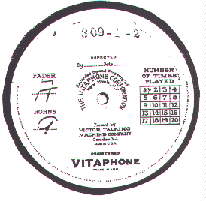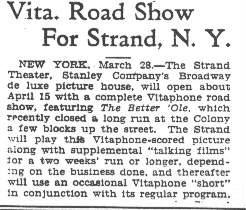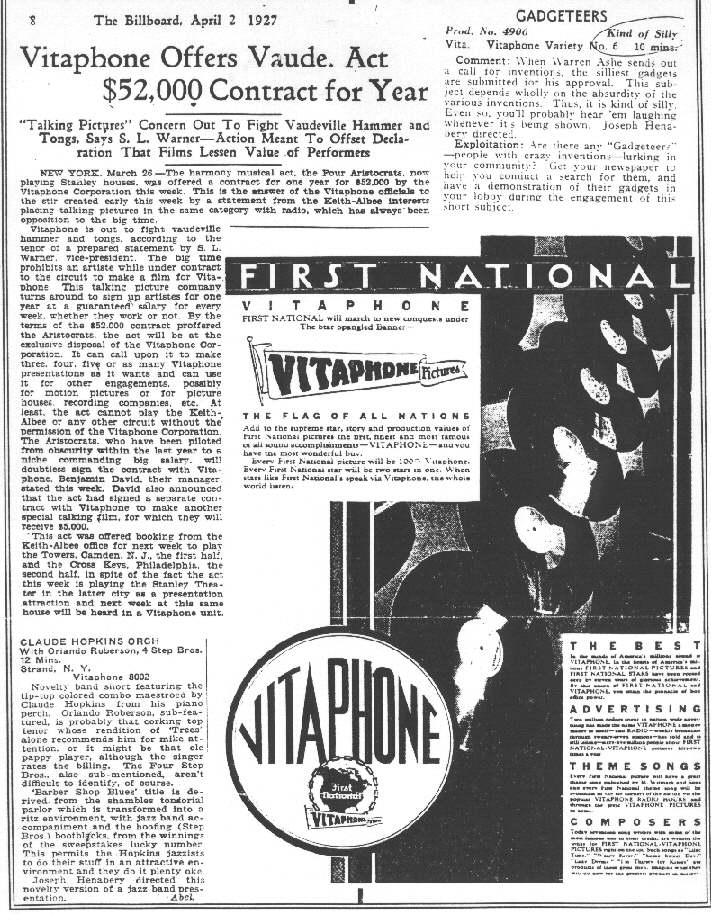


| Volume 1 Number 3 |
Winter 1992-1993
|
A monument to the earliest days of film making still stands in the Flatbush section of Brooklyn. Around 1907, the Vitagraph Studios were build on farmland on East 14th Street and silent films were produced there until 1925. During those two decades, stars like John Bunny, Constance Talmadge and Larry Semon turned out shorts and later features. The quality of the work was such that the miniatures used in the Vitagraph feature "Captain Blood" turned up later in the 1935 Warner's remake with Errol Flynn. By 1927, the studio was clearing $2 million per year. Then, efficiency experts turned it into "the morgue of the movies". It was acquired in 1925 by Sam Warner along with numerous Vitagraph exchanges.
Initial efforts to soundproof the place are wonderfully chronicled in Kevin Brownlow's "The Parade's Gone By". Suffice it to say that the elevated BMT subway trains that passed by the studio (it still does) didn't help sound recording! After temporarily moving to the New York Opera House to film the early Vitaphone shorts programs, the studios in Brooklyn were in operation in 1928.
In June, 1992, we visited them! Dave Goldenberg, Ron Hutchinson, John Newton, and Sherwin Dunner entered the arched studio entrance of what is now the Shulamith School for Girls. One of its students, Peri Horowitz, generously offered to arrange a tour after a series of coincidences led her to hear about our Project. Peri, Rabbi Zwick, sociology teacher Sandra Silverman and several other teachers and students gave us a full tour of the facilities.
Some highlights:
The original smokestack with "VITAGRAPH" emblazoned on inlaid brick is still there, as are the clearly delineated old (silent) and new (sound) buildings. What were sound stages 1 and 2 have the traditional bowed roof, and are separated by effective original soundproofing. Proof of its effectiveness is the fact that the school turned the stages into a gymnasium and auditorium, both of which can be used simultaneously. The original studio catwalks are still above the renovated area.Across the street is another huge sound stage which is now used by NBC Television for the production of soap operas.
Rabbi Zwick was present when the derelict complex was brought by the school over 20 years ago. He recalls the cavernous sound stages as being rat infested. It was clear where the studio machine shop, offices, props, elevator and other studio elements were located.
In answer to your question, no. There were no films or discs lying around!
The studio was apparently used for interiors in "On The Waterfront" (1954), as a door with a star on it labeled "Karl Malden" was found.
Dave and Ron returned to the school in December and spoke to Mrs. Silverman's sociology class and showed film clips of some Vitaphone shorts. The hit of the show was a scene from "Fatty" Arbuckle's 1933 short, "Buzzin' Around" which had extensive shooting outdoors immediately around the studio. The girls called out readily identifiable stores, buildings, and other landmarks. Some were now bagel shops and restaurants, but the area has changed suprisingly little in 60 years. At one point, the picture was frozen and the apartment building behind Arbuckle was identified as the one we could all see out of the classroom's window.
The class has written to nearly a dozen Vitaphone stars asking about their recollections of working in Brooklyn.
Following the talk, Dave and Ron (joined by famed leader of The Nighthawks Orchestra, Vince Giordano) visited the gas station across the street. It had a circa 1925 photo of the studio in its office. The station owner, Frank Rillo, recalled being in a 1936 Bergen and McCarthy short, "Nut Guilty", as a kid. Vitaphone apparently frequently selected members of the neighborhood to be extras in their films. Frank and a bunch of his little friends got new clothes and slingshots to pelt Charlie McCarthy and Bergen with mudballs in the film's finale. Subsequent discussions with Frank revealed many residents are still in the neighborhood who either worked at the studio, or who have recollections of its active years.
The Vitaphone Project is indebted to Peri and the school for allowing us to walk back in time through the Vitaphone Studio.
The value of networking with collectors, museums, archives, film and record organizations, and others cannot be overemphasized. Many people know that special "someone else" we should talk to, or who has discs, or other information to further the Project. Such networking has not only helped us track down people with discs in their own collection, but people with restored full Vitaphone projection/playback equipment, specialists in other early sound systems, performers, technicians and holders of rare nitrate film.
The Project has been particularly busy since the last issue in "getting the word out". On October 28th, Sherwin Dunner and Ron Hutchinson spoke at the Museum of Modern Art at a special seminar on film music. Earlier that month, Ron also guested on the wonderful "Big Broadcast" radio show hosted by Rich Conaty. Rich kindly let Ron plug the Project, and he even played some soundtracks. This marked the show's 1000th broadcast on WFUV-FM in New York, and other guests included Arthur Tracy, "The Street Singer" (who was in a 1932 Vitaphone "Rambling 'Round Radio Row"), Dolly Dawn (who Ron gave a dub of her 1935 Vitaphone with George Hall and Eddie Foy, Jr.), composers Mitchell Parrish ("Stardust") and Edward Eliscu ("Flying Down To Rio"), and Eddie Cantor's grandson, Brian Gari. Music was supplied by the incomparable Vince Giordano's Nighthawks.
Sherwin has placed a notice on the Project which appears in the FIFA Newsletter sent to every film archive in the world. It is known that many of the 1926-32 shorts were exported all over the world, and prints may exist overseas even if they're unknown in the U.S. Numerous other publications have run articles on the project, including New Amberola Graphic, Record Collector, Past Times, Cinefile, Variety and many more. Each article has yielded letters from enthusiastic supporters, many of whom have discs or films. Letters and articles will appear soon in Films In Review and Joslin's Jazz Journal. And Central New Jersey's Courier News ran a full page story on the Baby Rose Marie from her 1929 short, "The Child Wonder". This story has since been syndicated in all Gannett papers nationally.
We also continue to rely on YOU to help spread the word on The Vitaphone Project. If you know of film or record collectors who may have elements, or have any leads at all on archives, nitrate film vaults, paper and other ephemera, please let us know. You can be assured that we will follow up immediately so that our body of knowledge on Vitaphone can continue to expand.


Bill Capello can well be called Mr. Keen, Tracer of Lost Persons. He has a knack for tracking down obscure performers, or their relatives. He's found family members of such diverse people as Miss Crabtree of The Little Rascals and comedienne Gay Seabrook. Bill contacted the Project with helpful info on the Home Talkie Films of 1929-30, then helped us find the relatives of vaudevillian Georgie Price who made a number of Vitaphone shorts. Price was a kind of combination Eddie Cantor and Al Jolson. We've talked to Georgie's son, daughter and son-in-law, and will share our findings in a future issue... Dolly Dawn sang with George Hall's Orchestra and her own Dawn Patrol in the thirties and forties. We met and spoke with Dolly in October and gave her a copy of her 1935 Vitaphone short with Eddie Foy, Jr. She recalls having to get to the studio around 5 AM so they could shoot, then get to the Paramount for a 9 Am show, then to the Hotel Taft for the evening... 93 year old Arthur Tracy, "The Street Singer", made a brief appearance in a 1933 "Rambling 'Round Radio Row" for Vitaphone shot in Central Park. He now has a copy of it... author Ed Watz has just finished a book on the comedy team of Wheeler & Woolsey, and generously shared material on Wheeler's 1929 Vitaphone, The Small Timers". Ed tells us Wheeler met Fatty Arbuckle, an old friend, in a New York hotel in 1933, then later was shocked to see Arbuckle's body being carried out that evening after he died suddenly...
Supporters of the Project are particularly looking for copies of the following films, or any information (casts, songs) known about them:
If you are looking for a particular film, or other specific information on Vitaphone or other early sound shorts, write to us at the Project.

Full set for "Hold Everything" (1930)... independently produced Fowler Studios shorts circa 1929-30... discs for many Pathe shorts 1929-31... Vitaphone shorts discs for films by Dick Rich and His Syncho Symphonists (1927), Georgie Jesse's 1926 short in which he kids Martinelli on another short in the same program, Jack Osterman with Ruth Etting and Arden & Ohman... all discs for "Hollywood Revue of 1929"... Hal Roach shorts "Wrong Again" (Laurel & Hardy, 1928, music and effects), Harry Langdon's "The Head Guy" and "Lazy Days", an early Our Gang talkie... Spanish language discs for "The Emperor Jones" (1933) with Paul Robeson... MGM-Movietone and Vitaphone discs for Van & Schenck shorts... discs for 1928-29 Fox Clark & McCullough comedy shorts and featurettes... Coming attractions/trailer discs for "The Office Wife", "Little Johnny Jones", Hot Stuff", "Sonny Boy", Capra's "The Donovan Affair"... complete set of discs for the 1929 Columbia feature musical "Broadway Scandals", and the Universal feature "Dance Ahoy!"... some discs for 1928 British Phototone shorts.
Many thanks to the nearly two dozen of you who have kindly sent us donations of $5 each or more to help keep The Vitaphone News coming. As you know, this project is a labor of love for all involved. We will continue to send the News to anyone who is interested in our efforts, but contributions to help towards our postage and printing cost sure are appreciated!
If you'd like to help, a $5.00 donation can be sent to us at The Vitaphone Project, 5 Meade Court, Piscataway, NJ 08854. Checks should be made out to Ron Hutchinson. Again, thanks to all of you who have already contributed!
Author and film historian Richard Bann is actively seeking soundtrack discs for any 1928-31 Hal Roach comedies. Most of Roach's early sound product was issued only with the track on disc, and many key films remain mute. Dick recently obtained a print of the tantalizingly titled Charlie Chase 1929 talkie (his fourth) titled "Crazy Feet", but with no sound. Much of Roach's 1928 production was issued to theatres with synchronized music and effects discs. Stars included Laurel & Hardy, Our Gang, Charlie Chase, Harry Langdon, Thelma Todd, and the All Stars. If you have or know of any Roach discs, please let Dick know through The Vitaphone Project.
Jim Bedoian's Take Two Records issued several vinyl LP's years ago made up entirely of sound tracks from Vitaphone discs. "A Night At The Palace" featured performances by such vaudeville luminaries as Georgie Price, Willie & Eugene Howard, The Seven Little Foys', Van & Schenck, Harry Fox and Benny Fields & Blossom Seeley. Another had discs from trailers for 1928-30 talkies. As we await the reissue on CD of these two productions, we can highly recommend Jim's Sophie Tucker Cd (Take Two TT404), "Jazz Age Hot Mamma". In addition to some of Sophie's 78's, Jim has provided six songs from the soundtrack of Sophie's 1929 Warner's Vitaphone feature, "Honky Tonk". Incidental dialog and complete versions of "I'm The Last of the Red Hot Mammas", "He's A Good Man To Have Around", "I Don't Want To Get Thin", "Take Off Your Mask And Be Yourself", "I'm Doing What I'm Doing For Love", and "I'm Feathering A Nest" are heard. To order Take Two's catalog and records write to P.O. Box 36729, Los Angeles, CA 90036, or call (213) 939-4419.

Film buffs will recognize the name Joseph Henabery. He played Abraham Lincoln in D.W. Griffith's "Birth of A Nation" (1915), and later directed Arbuckle, Fairbanks and Valentino in silent features. In the mid-twenties, Henabery had a run-in with Louis B. Mayer and was blacklisted from Hollywood. He finished out the decade directing potboilers for First national and Universal. By 1931, Henabery was hired by friend Sam Sax, who now ran the Brooklyn Vitaphone studios. Joe's first assignment was a series of S.S. Van Dine 2-reel mysteries with John "Perry White" Hamilton and Donald Meek. His technical expertise soon made him a natural for musicals with Ruth Etting, Dave Apollon, and countless orchestras.
In the mid-thirties, Vitaphone began an annual tradition of "kiddie" shorts featuring singing, tap dancing or otherwise talented children from the New York area. "Trouble in Toyland" and "Toyland Casino" are two examples that crop up regularly on TNT. These made a mint at New York theatres as all the kid's relatives would repeatedly pack the theatres when these shorts played. Henabery directed them and braved countless auditions at talent schools.
Just before the Brooklyn studios closed in 1939, Henabery was sent to England by Sax to begin directing British Warner features. Sadly, war was declared after only weeks of shooting, and Jack Warner invoked a "war clause" which forced Henabery to pay his own way back to America... and a closed Vitaphone studio! He helmed one Hopalong Cassidy feature in 1943, then finished his career directing industrial films (many of which were superb).
Having seen Henabery's name on the credits of countless Vitaphone shorts of the thirties, we hopefully checked the Manhattan directory for anyone with that last name. There was just one, Bob Henabery. We called and asked him if he was in any way related to director Joe Henabery. The answer made this stab in the dark worthwhile: "Yes, he was my dad!" So began a wonderful friendship between Ron Hutchinson of the Project and radio consultant Bob Henabery.
During the first meeting at Bob's place, boxes upon boxes of Joe's memorabilia were scanned. Subsequent meetings allowed full inventorying of this exciting material. The silent period was represented by countless original and annotated scripts for Arbuckle, Valentino, and Fairbanks features; hundreds of stills, including behind the scenes and gag stills; hundreds of reviews, clippings and treatments; original letters from Griffith and Fairbanks; every contract from 1928-1946, at Vitaphone, Paramount, Columbia, First National and many more.
At first, the entire Vitaphone period appeared to be missing. But on the last day of inventorying, an entire bundle of this material was found. Of particular interest were production stills on the making of the shorts; a priceless autographed photo of Henabery making a fist for Jack Dempsey from a short the legendary fighter made; a group short of Vitaphone's mid-thirties directors surrounding studio head Sam Sax in his ultra-Deco Brooklyn office; scripts, production schedules and contracts.
Bob Henabery has become an enthusiastic supporter and friend of The Project. We've given him dubs of some of his father's many films, which he recalls seeing when they first came out. He also remembers being bored on his visits to the studio, and that while his dad had a "tin ear", he always seemed to be assigned the musical films.
Future issues will include photos and clippings from Joe Henabery's collection.
We cannot let another issue of The Vitaphone News go by without saluting the foremost authority on the restoration of early sound films, Bob Gitt of UCLA. For a wonderful review of Bob's activities in researching, documenting, and restoring Vitaphone films, we highly recommend that you buy a back issue of American Cinematographer magazine, September 1990. Bob has done more than anyone to actively save these films, and to develop their restoration to an art. He was part of every film buff's dream when a huge cache of Vitaphone discs (many in original sleeves and unplayed) were discovered a few years ago behind a projection screen at Warner Brothers studios. The story goes that rock musicians used to throw discs around like Frisbees!
Bob and film historian Anthony Slide (his new book, "Nitrate Won't Wait", is outstanding) have done wonderful work in bringing examples of early motion picture technology (sound, color, 3-D, wide screen, etc.) into view again. Bob's facilities at UCLA are equipped to re-synch disc and film elements, and to bring out sound previously unheard from the grooves.
We see the Vitaphone Project as a supportive effort to Bob's work at UCLA. All of our findings will be shared with UCLA and other film archives (minus the holder's names until approved, of course). Of particular interest is the tracking down of the film portions of films for which only the discs exist.
Bob Gitt's name has become synonymous with early sound film research and restoration. We vigorously support him and his legendary work.


|
Ron Hutchinson:
|
Corresponding Secretary |
|
Sherwin Dunner:
|
Data Base |
|
David Goldenberg:
|
Newsletter, Advertising, |
|
and John Newton:
|
Publicity |
Do you have film soundtrack discs (Vitaphone, Paramount, MGM, etc.),
production information, stills, or other ephemera on pre 1940 short films?
We urgently need this data for a major film restoration program.
Replies will be kept confidential. Project endorsed by copyright
owners.
THE VITAPHONE PROJECT
To contact The Vitaphone Project write to:
Ron Hutchinson
5 Meade Court
Piscataway, NJ 08854
or email Ron at medusashaircut@erols.com
or project member Bill Cappello at billcapp@ix.netcom.com